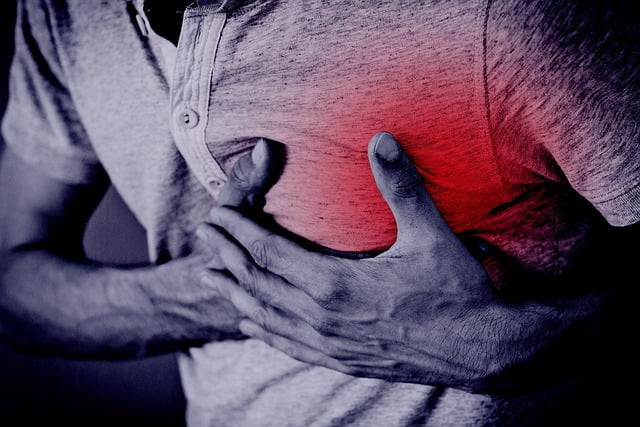I. Introduction
Heart attacks, also known as myocardial infarctions, are frightening events that occur when the blood flow to a part of the heart is blocked. They are serious medical emergencies that require immediate attention. Knowing the symptoms is important for prompt medical intervention, which can save lives.
II. Heart Attack Symptoms
Identifying the symptoms of a heart attack is necessary for seeking timely medical help. Common symptoms include:
- Chest pain or discomfort
- Shortness of breath
- Nausea or vomiting
- Sweating
- Lightheadedness or dizziness
- Pain or discomfort in the arms, back, neck, jaw, or stomach
III. Heart Attack Symptoms in Women
Women may experience attack symptoms differently from men. Symptoms in women can include:
- Chest pain or discomfort
- Pain in the back, neck, jaw, or stomach
- Shortness of breath
- Nausea or vomiting
- Sweating
- Fatigue
Women need to be aware of these symptoms and seek medical attention if they experience any of them.
IV. Heart Attack Grill:
What You Need to Know?
The Heart Attack Grill, despite its name, is a debated restaurant known for its high-calorie, unhealthy menu items. While it may attract attention due to its stimulating theme, it’s important to highlight heart-healthy eating habits to prevent heart disease and attack.
V. Heart Attack Lyrics:
A Reflection on Heartbreak
“Heart Attack” by Demi Lovato is a popular song that explores themes of heartbreak and emotional weakness. While the lyrics may resonate with listeners on an emotional level, it’s important to understand the physical implications of attacks and highlight heart health.
VI. Heart Attack Grill Menu
The menu at Heart Attack Grill has several extremely high-calorie items, like the “Flatliner Fries” and the iconic “Quadruple Bypass Burger.” While treating yourself once in a while is acceptable, eating a balanced diet is important for lowering your risk of heart disease and attacks.
VII. Heart Attack Symptoms in Men
Men may experience classic symptoms, including chest pain and shortness of breath. Men need to pay attention to their bodies and seek medical help if they experience any relating to symptoms.
VIII. Heart Attack in Women:
Understanding Gender Differences
That disease are apparent differently in women compared to men. Women are more likely to experience atypical symptoms such as nausea, back pain, and jaw pain. Understanding these gender differences is necessary for early detection and treatment.
IX. Heart Attack vs. Cardiac Arrest:
Understanding the Difference
While often used interchangeably, heart attacks and cardiac arrests are different medical happenings. A heart attack occurs when blood flow to the heart is blocked, whereas cardiac arrest is the sudden loss of heart function. Knowing the difference is essential for responding effectively in emergencies.
X. Heart Attack Grill Las Vegas:
A Tourist Attraction with a Warning
The Heart Grill in Las Vegas attracts tourists with its provocative theme and high-calorie menu items. However, it’s important to select health and make informed choices when dining out, even in novelty restaurants like this one.
XI. Heart Attack by Demi Lovato:
Exploring Mental Health Themes
By Demi Lovato explores themes of vulnerability and emotional struggles. While the song may resonate with listeners, it is necessary to prioritize both physical and mental health to lead a fulfilling life.
XII. Heart Attack Definition:
What Exactly Happens?
When a portion of the heart’s blood supply is cut off, usually due to plaque accumulation in the coronary arteries, attack takes place. The injured or dead cardiac muscle might result from insufficient blood supply. Timely medical attention is necessary to reduce harm and enhance results.
XIII. Heart Attack Causes:
Understanding Risk Factors
Several factors can contribute to the development of heart disease and increase the risk of attacks. These include:
- High blood pressure
- High cholesterol
- Smoking
- Obesity
- Diabetes
- Family history of heart disease
By addressing these risk factors through lifestyle changes and medical interventions, individuals can reduce their risk of experiencing that disease.
XIV. Heart Attack Gun:
Separating Fact from Fiction
The “heart attack gun” is a conspiracy theory suggesting that a covert weapon exists capable of inducing attacks. However, there is no credible evidence to support this theory, and it remains a topic of thought rather than scientific fact.
XV. Heart Attack Treatment:
Saving Lives with Timely Intervention
People who are having attack need to get medical attention right away. Medication to dissolve blood clots, angioplasty, and stenting to restore blood flow, and lifestyle changes to prevent additional cases are possible forms of treatment.
Conclusion
Heart attacks are serious medical emergencies that require prompt attention. By recognizing the symptoms, understanding gender differences, and high-priority heart-healthy habits, individuals can reduce their risk of experiencing of it and lead healthier lives. Remember, early mediation saves lives. Take care of your heart today for a healthier tomorrow.
Signs in the form of table:
Sure, here’s a table outlining the signs of a heart attack in men and women, along with precautions:
| Signs | Men | Women | Precautions |
|---|---|---|---|
| Chest Pain | Typically described as pressure, squeezing, or tightness | May not always experience chest pain, may feel pressure or discomfort | Seek immediate medical attention if experiencing chest pain |
| Pain Radiating | Pain may radiate to the left arm, neck, jaw, or back | Pain may radiate to the jaw, neck, shoulder, back, or abdomen | Understand that pain can manifest in different areas, not just the chest |
| Shortness of Breath | Often present | May experience shortness of breath without chest pain | Pay attention to any sudden onset of breathlessness |
| Nausea/Vomiting | Common | May experience nausea or vomiting | Seek medical help if nausea or vomiting accompanies other symptoms |
| Fatigue | Common | Often present but may be more subtle | Don’t ignore unusual fatigue, especially if it’s sudden |
| Dizziness | May occur | May experience lightheadedness or dizziness | Sit or lie down if feeling dizzy or lightheaded |
| Sweating | Common | May experience cold sweats | Be aware of any sudden, unexplained sweating |
Precautions:
- Know the Signs: Educate yourself and your loved ones about the signs and symptoms attack in both men and women.
- Act Quickly: If you or someone else experiences symptoms of it, seek emergency medical attention immediately.
- Don’t Ignore Discomfort: Even if symptoms are mild or atypical, don’t dismiss them. It’s better to be safe and get evaluated by a healthcare professional.
- Manage Risk Factors: Maintain a healthy lifestyle by eating a balanced diet, exercising regularly, managing stress, quitting smoking, and controlling conditions such as hypertension, diabetes, and high cholesterol.
- Regular Check-ups: Schedule regular check-ups with your doctor to monitor your heart health and discuss any concerns or risk factors.
- Learn CPR: Knowing CPR (Cardiopulmonary Resuscitation) can be life-saving in emergency situations. Consider taking a CPR course to learn the basics.
- Have an Emergency Plan: Know the nearest hospital or healthcare facility where you can seek help in case of a heart emergency. Keep emergency contact numbers handy .





3 thoughts on “Early 6 heart attack symptoms in men and women, causes, Treatments”